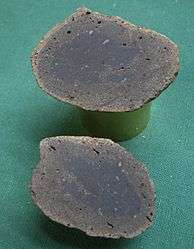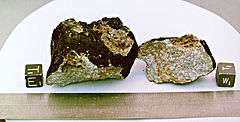Eucrite
| Eucrite | |
|---|---|
| — Group — | |
 Stannern eucrite, found in the Czech Republic. | |
| Compositional type | Stony |
| Type | Achondrite |
| Class | Asteroidal achondrite |
| Clan | HED meteorite |
| Subgroups |
|
| Parent body | 4 Vesta and others |
| Composition | Basaltic rock, mostly Calcium-poor pyroxene, pigeonite, and Calcium-rich plagioclase (anorthite) |
| Total known specimens | >100 |
 GRA98033 a brecciated eucrite about 5 cm across, found in the Graves Nunataks region of Antarctica. | |
Eucrites are achondritic stony meteorites, many of which originate from the surface of the asteroid 4 Vesta and as such are part of the HED meteorite clan. They are the most common achondrite group with well over 100 distinct finds at present.
Eucrites consist of basaltic rock from the crust of 4 Vesta or a similar parent body. They are mostly composed of Ca-poor pyroxene, pigeonite, and Ca-rich plagioclase (anorthite).[1]
Based on differences of chemical composition and features of the component crystals, they are subdivided into several groups:[2]
- Non-cumulate eucrites Are the most common variety and can be subdivided further:
- Main series eucrites formed near the surface and are mostly, though not exclusively, regolith breccias lithified under the pressure of overlying newer deposits.
- Stannern trend eucrites are a rare variety.
- Nuevo Laredo trend eucrites are thought to come from deeper layers of 4 Vesta's crust, and are a transition group towards the cumulate eucrites.
- Cumulate eucrites are rare types with oriented crystals, thought to have solidified in magma chambers deep within Vesta's crust.
- Polymict eucrites are regolith breccias consisting of mostly eucrite fragments and less than one part in ten of diogenite, an arbitrary dividing line from the howardites, which are related in structure. They are comparably rare.
Etymology
Eucrites get their name from the Greek word eukritos meaning "easily distinguished". This refers to the silicate minerals in them, which can be easily distinguished because of their relatively large grain size.
Eucrite is also a now obsolete term for bytownite-gabbro, an igneous rock formed in the Earth's crust. The term was used as a rock type name for some of the Paleogene igneous rocks of Scotland.[3]
See also
References
- ↑ B. Mason: Meteorites. John Wiley, New York 1962.
- ↑ Mittlefehldt, McCoy, Goodrich and Kracher: Non-chondritic Meteorites from Asteroidal Bodies, In: Reviews in Mineralogy Vol. 36, Planetary Materials, Mineralogical Society of America, 1998.
- ↑ Sutherland, D. S. (1982) Igneous Rocks of the British Isles, Chichester, John Wiley, page 536.
External links
- Eucrite images - Meteorites Australia